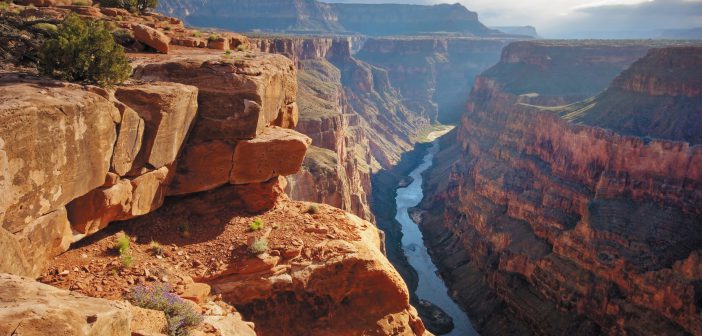The hotel industry benefits from the upkeep of these environmental treasures.
by MARCIA ARGUST
National parks are American treasures. From a mirrored lake in Montana’s Glacier National Park to the walls of the Grand Canyon in Arizona that tell the geological history of the site. From the patriotic monuments that dot our nation’s capital to the colorful hillsides that appear every fall along America’s parkways, the national parks are a major draw for tourists from across the country and around the world.
Last year’s centennial celebration of the National Park Service (NPS) pulled in a record 331 million visits to the system’s more than 400 sites. Not only are the parks environmental treasures, they’re also economic engines for neighboring communities. In 2016, NPS visitors spent $18.4 billion in nearby communities, and the hotel industry was a top beneficiary.
More than 30 percent of the spending – $5.7 billion – went to lodging. The second highest expenditure – 20 percent – went to the restaurant industry, which took in $3.7 billion.
In the 1950s, when people took to the new interstate highways, national parks were often a favorite destination. Unfortunately, many visitors found inadequate bathrooms and crumbling infrastructure. This created widespread public concern at the time, which led Congress to invest in our country’s iconic places.
Lawmakers implemented a plan, called Mission 66, which allocated close to $1 billion – the equivalent of about $7 billion to $8 billion today – for visitor centers, adequate roads, improved bathroom accommodations, and other amenities to provide a safe, enjoyable experience for park visitors.
But that was 50 years ago, and the time has come for another round of repairs to these popular national treasures, which have been inadequately funded by Congress for decades. At the same time, the parks have grown in popularity, meaning more wear and tear on aging and deteriorating infrastructure. And as hoteliers know, infrastructure maintenance is a key part of business success. That is why it’s so troubling that federal investment in park maintenance has fallen well short of the billions of dollars needed today to repair the crumbling roads, deteriorating historic buildings, eroding trails, outdated public buildings and safety hazards in our national parks. These issues can impede access, compromise safety and hinder the preservation of the very history that may have resulted in the site becoming part of the National Park Service.
Troubled waters at the Grand Canyon
Grand Canyon National Park is a perfect example of eroding infrastructure. More than 6 million visits a year are made to the Arizona site for a close-up look at the mile-deep canyon carved by the Colorado River. And the park’s biggest problem, ironically, is water.
Gravity feeds 1.2 million gallons a day over 16 miles of aluminum pipe from the North Rim to the more popular South Rim. But this Trans-Canyon Pipeline, which is integral to the park’s infrastructure and operations, has a history of breaking 20 times or more a year. When a break occurs, park staff scramble – sometimes by helicopter – to locate and patch the pipeline at great cost in resources and staff time. Sometimes when the pipeline is damaged, concessioners, residents and guests have to ration water, which can discourage visitation and jeopardize tourism dollars.
The solution would be replacing the pipeline. NPS officials onsite estimate the project could cost more than $150 million. But the cost of continuing to neglect this vital asset of the park could be even higher. In 2016, visitors spent an estimated $648 million in areas adjacent to the park, with the NPS estimating that $168 million of that spending, or 26 percent, was on lodging at nearby hotels. The total visitor spending in these areas supported 9,800 jobs and $904 million in economic output.
The NPS wants to avert these situations, but the agency often lacks the federal funding to make infrastructure repairs at the Grand Canyon and other sites. Yet as repairs are put off, the cost of interim fixes adds up and permanent solutions become more expensive.
It’s not too late for Congress to address the deferred maintenance challenges within our parks. Sen. Mark Warner, D-Va., along with Sen. Rob Portman, R-Ohio, introduced the National Park Service Legacy Act to establish a dedicated annual fund to address park deferred maintenance, eventually allocating up to $500 million per year through 2047. Rep. Will Hurd, R-Texas, along with Reps. Derek Kilmer, D-Wash., Dave Reichert, R-Wash., and Colleen Hanabusa, D-Hawaii, recently introduced companion legislation in the House of Representatives.
Preserving these beloved places for future generations would also support businesses across the country that depend on revenue from park visitors. As we continue to celebrate the historical, cultural and recreational values of America’s national parks, we must also invest in the park infrastructure those guests depend upon during their visits.
AAHOA is among the businesses and organizations around the country that recognize the importance of the national parks to the hotel industry. You can help ensure that NPS has the dedicated resources necessary to protect and maintain our national parks by urging your representative and senators to co-sponsor the National Park Service Legacy Act. Together, we can help #FixOurParks.




